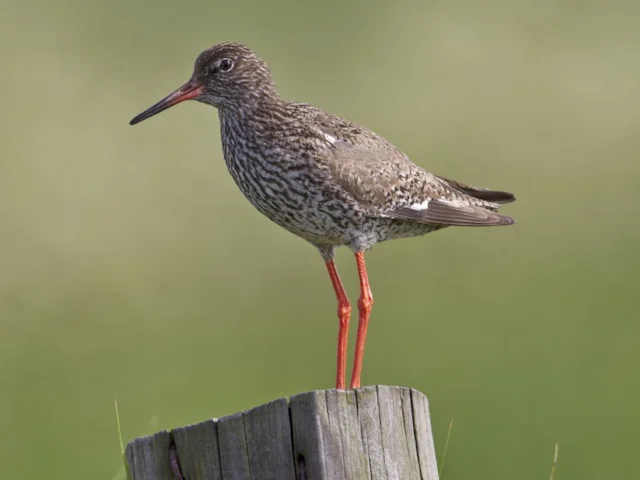Remove a Hedgehog, save a wader
63f334b7-d253-446a-8cdc-1503a0a6f70a

Scottish Natural Heritage (SNH) will protect the internationally important numbers of breeding waders on the Outer Hebrides by removing all the introduced Hedgehogs on the islands.
Local wildlife – such as the Outer Hebrides' famous breeding waders – is recognised as a key asset for tourism, and is believed to be worth around £53 million a year there, and there are plans to grow this figure to £63 million over the next five years. The Uists alone support nesting Dunlin, Ringed Plover, Common Redshank, Common Snipe, Northern Lapwing and Oystercatcher, but numbers have been declining since the mid-1980s, partly due to egg predation by non-native Hedgehogs.
Efforts to stem the shorebird decline have been in progress since 2004, with translocation of trapped Hedgehogs being deployed since 2007 as a non-lethal solution. Earlier this month (February 2015), proposals to mount a fresh drive to save these internationally important numbers of waders were backed by community leaders in the Outer Hebrides.
Research in 2012-14 showed that Hedgehogs were predating eggs and occasionally small chicks, and were having a major impact on the breeding success rates of waders in European Special Protection Areas (SPAs) on South Uist.
A range of solutions was presented to SNH in Inverness, including the removal of Hedgehogs, clearing them from SSSIs and European SPAs, or simply leaving them to breed. One of the removal options the board was asked to consider concerned Hedgehog removal from the Uists in two five-year phases, at a cost of around £2.9 million over five years, shrinking to around £2.1 million over the following five years for phase two. This 10-year project would aim to see the ultimate removal of all Hedgehogs, giving wader populations a chance to stabilise and recover.
Ian Ross, SNH chairman, commented: “Action is proposed to counter the worrying decline in key wader species on the Uists. Managing invasive non-native species is a high priority in the islands. This would represent not only an investment in the natural heritage, but also the character, culture and economic future of the islands. We are committed to removal of the Hedgehogs, which [will be] trapped safely and humanely, and removed from the Uists to the mainland.”
Paul Walton, head of RSPB Scotland’s species and habitats department, said: “RSPB Scotland commends these renewed efforts from SNH to secure funding to help the breeding waders of Uist. The key message in this challenging work is that everyone should be careful not to release non-native animals into the wild, especially on islands.”
Nature-based tourism is recognised in the Tourism Outer Hebrides Strategy 2020, with the internationally important wader populations one of the key attractions for visitors early in the season. There is a risk that less visitors will come if there are no waders to see, thus having an adverse effect on the local economy.
Local wildlife – such as the Outer Hebrides' famous breeding waders – is recognised as a key asset for tourism, and is believed to be worth around £53 million a year there, and there are plans to grow this figure to £63 million over the next five years. The Uists alone support nesting Dunlin, Ringed Plover, Common Redshank, Common Snipe, Northern Lapwing and Oystercatcher, but numbers have been declining since the mid-1980s, partly due to egg predation by non-native Hedgehogs.
Efforts to stem the shorebird decline have been in progress since 2004, with translocation of trapped Hedgehogs being deployed since 2007 as a non-lethal solution. Earlier this month (February 2015), proposals to mount a fresh drive to save these internationally important numbers of waders were backed by community leaders in the Outer Hebrides.
Research in 2012-14 showed that Hedgehogs were predating eggs and occasionally small chicks, and were having a major impact on the breeding success rates of waders in European Special Protection Areas (SPAs) on South Uist.
A range of solutions was presented to SNH in Inverness, including the removal of Hedgehogs, clearing them from SSSIs and European SPAs, or simply leaving them to breed. One of the removal options the board was asked to consider concerned Hedgehog removal from the Uists in two five-year phases, at a cost of around £2.9 million over five years, shrinking to around £2.1 million over the following five years for phase two. This 10-year project would aim to see the ultimate removal of all Hedgehogs, giving wader populations a chance to stabilise and recover.
Ian Ross, SNH chairman, commented: “Action is proposed to counter the worrying decline in key wader species on the Uists. Managing invasive non-native species is a high priority in the islands. This would represent not only an investment in the natural heritage, but also the character, culture and economic future of the islands. We are committed to removal of the Hedgehogs, which [will be] trapped safely and humanely, and removed from the Uists to the mainland.”
Paul Walton, head of RSPB Scotland’s species and habitats department, said: “RSPB Scotland commends these renewed efforts from SNH to secure funding to help the breeding waders of Uist. The key message in this challenging work is that everyone should be careful not to release non-native animals into the wild, especially on islands.”
Nature-based tourism is recognised in the Tourism Outer Hebrides Strategy 2020, with the internationally important wader populations one of the key attractions for visitors early in the season. There is a risk that less visitors will come if there are no waders to see, thus having an adverse effect on the local economy.

